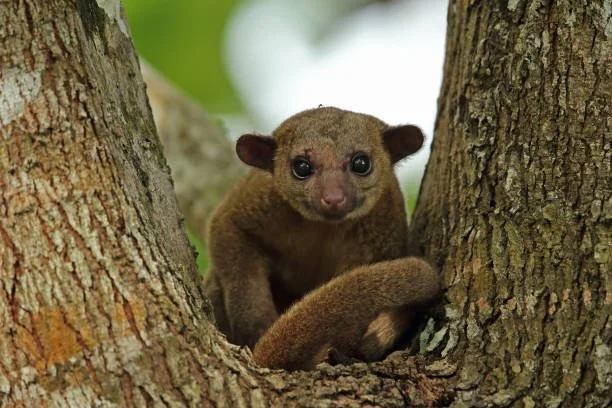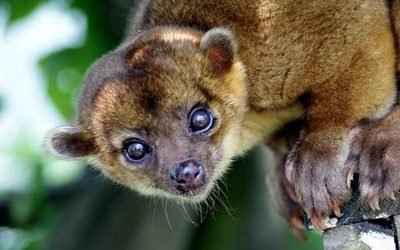Here at the Lost and Found Hostel we have a very special friend of ours who we call Rocky. Rocky has been a long-term guest of ours and we definitely consider him to be a part of the family. However, Rocky is no ordinary guest. Unlike most guests, Rocky has a very long prehensile tail, claws, only functions at night (similar to some around the hostel) and eats strictly fruits. You may have guessed by now, but Rocky is not a person but an animal called a Kinkajou.
Rocky is a rescue animal who we now take care of at the Lost and Found and you can visit him at night to check in on him and see how he is doing. If you are lucky enough, Rocky will walk up to the fence and come say hello. Just make sure to listen carefully at night as you walk by him! He might start banging on the fence, which usually means he wants you to come and say hello. Rocky loves the attention and some good pets for sure, but he is just one of many Kinkajous in the world. If you are interested in learning more about our good friend and those like him, keep reading for some awesome kinkajou facts!
10 Facts
Another name for a Kinkajou is a Honey Bear because of their claws and their rounded ears.
Kinkajous are the only species of the genus Potos
Kinkajous are arboreal and possess many arboreal adaptations, such as a long prehensile tail, nimble clawed fingers, and fully reversible hind feet.
The peak activity of a Kinkajou is usually between 7 p.m and midnight, and again an hour before dawn. During the day, kinkajous sleep in tree hollows or shaded tangles of leaves, avoiding direct sunlight.
Studies have shown that 90% of a Kinkajous diet consists of fruit. The other ten percent is made up of leaves, flowers, and various other herbs. On rare occasions they eat eggs, hatchlings, insects, and small vertebrates.
Interestingly, kinkajous are important pollinators. As they travel from flower to flower, drinking nectar, the flower’s pollen sticks to the kinkajous face and smears off on the next flower.
Kinkajous live in small social groups that usually consist of two males, one female, and related offspring. Members of the same group sleep together during the day in a shared nest or den and emerge at dusk to groom and socialize. They wander off to feed alone for most of the night but come back together in the morning to sleep.
Kinkajous are highly vocal, emitting screams, barks, and a variety of softer sounds, including some described as “sneezes.”
Kinkajous breed throughout the year, giving birth to one or occasionally two small babies after a gestation period of 112 to 118 days. A mother kinkajou takes full responsibility for caring for her young(s). After one or two weeks, the baby’s eyes open. It begins to eat solid food at eight weeks. By this time, the youngster can hang by its tail. It is able to climb with confidence when it is about three months old.
Although kinkajous may look like monkeys or ferrets, they are not related to those animals.They are related to olingos, coatis, raccoons, and the ringtail and cacomistle.
I hope this blog was informative and that you learned something new! Now it is time to go and feed Rocky!



